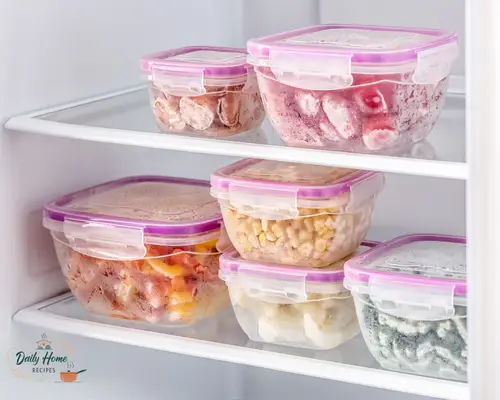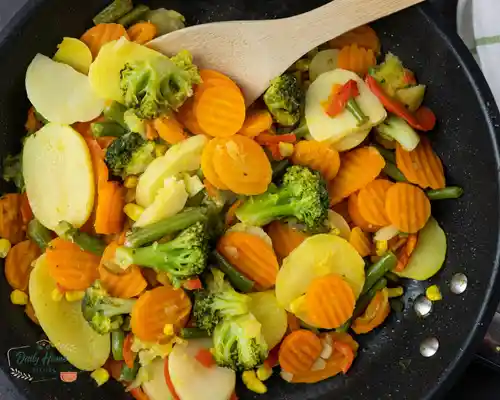Let’s be honest: if you’re exhausted by the question “What’s for dinner?” every. single. day. you’re not alone. It’s not that you hate cooking (okay, maybe a little), but the daily grind of planning, chopping, timing, and cleaning? It wears you down.
Here’s the thing: most meal prep advice is either too ambitious (12 glass containers of chicken and broccoli) or too vague (“Just plan ahead!”). What you need isn’t a rigid plan or an aesthetic fridge it’s a low-friction system that fits into your real life. One that doesn’t ask for your entire Sunday or your last bit of energy.
In this guide, we’ll walk through a realistic one-hour weekend setup that simplifies your week not just by saving time, but by reducing the number of decisions you have to make. We’ll talk containers that actually work (not the ones with missing lids), how to zone your fridge and freezer so nothing gets buried, and the pantry staples that let you throw together a satisfying dinner when your brain is fried.
No perfection, no pressure just a smarter way to prep for the week without cooking your will to live.
How to Set Up a 1-Hour Weekend Prep
Okay, let’s get something straight: you don’t need to spend your Sunday sweating in the kitchen just to “feel productive.” That’s not the point here. This isn’t about cranking out ten matching containers of chicken and rice unless that’s your thing (no judgment). It’s about giving your future self a break. A little cushion. A fridge full of “almost there” instead of “nothing to work with.”
You’re Not Prepping Meals You’re Laying the Foundation
Here’s what changed everything for me: I stopped prepping meals and started prepping components. Think of it like building a LEGO set way easier when the pieces are already sorted.
So instead of locking yourself into one flavor or dish, you cook:
- One or two grains or carbs that can be reused: rice, couscous, pasta, roasted potatoes.
- A couple of proteins or “main events” nothing fancy. Chicken thighs. Roasted chickpeas. Maybe tofu if you’re feeling virtuous.
- A bunch of washed, chopped veg that don’t turn sad after two days.
This gives you options like actual options midweek, when you’re tired and staring into the fridge wondering what the hell to make.

Let’s Be Real About the Time Breakdown
Forget the fake Pinterest timelines. Here’s what this hour actually looks like for most of us:
- 0–10 mins: You start the rice or whatever’s your base. Maybe throw some seasoning on the protein.
- 10–25 mins: Veggies you rinse, chop, snack on a few out of boredom. Protein’s in the oven or air fryer.
- 25–45 mins: Everything’s cooking or cooling. You portion things if you want to feel accomplished.
- Last 10 mins: Maybe you whip up a quick dressing or sauce. Maybe you don’t. Either way, you’re closer to peace.
No one’s timing you. If it takes 75 minutes, fine. If it’s just 45 and you quit early? Still a win.
Do I have to do it on Sundays?
Nope. Do it whenever you’ve got a window that doesn’t make you resent your own kitchen. I know people who do it Friday nights while watching Netflix. Others split it into two 30-minute blocks across the week. The real key? Make it feel doable, not like a second job.
Smart Containers, Grains & Produce Hacks
Let’s talk gear not in a techy, influencer-haul way, but in a “why does this lid never fit that container?” kind of way. Because the truth is, no matter how good your prep game is, the wrong containers (or grains, or soggy produce) will sabotage the whole thing.
Containers: The Unsung Heroes (and Headaches)
There are two kinds of containers: the ones you reach for automatically, and the ones that haunt the back of the drawer with no matching lid. You already know which ones you trust probably glass with tight lids or those bento-style divided trays that don’t leak soup onto your sandwich. Use them. Commit to a few good ones and toss the rest. Seriously. Life is too short for warped plastic.
Also? Labeling sounds cute until you’re peeling off sticky notes at 10pm. Instead, go transparent and stack smart proteins on one shelf, carbs on another. Visual simplicity saves brainpower.
Grains That Hold Up All Week (And Ones That Don’t)
Not all carbs age gracefully. White rice gets weird fast. Couscous stays fluffy. Farro? Nearly indestructible. Pasta can work, but oil it a bit or you’ll end up with one giant noodle blob by Wednesday.
Pick one or two:
- Microwave-friendly: jasmine rice, quinoa, couscous
- Sturdy + reheats well: farro, bulgur, barley
- Wildcard: roasted sweet potatoes or squash cubes (more versatile than you think)
And let’s stop pretending you always have to cook these from scratch. Pre-cooked microwave pouches are legit lifesavers. Anyone telling you otherwise is probably not the one doing the dishes.
Produce Without the Guilt Trip
Here’s the deal: some weeks you’ll lovingly chop a rainbow of fresh veg. Other weeks? You’ll buy the pre-chopped mix and call it a win. Either way, the trick is storing them in breathable containers with a paper towel (to soak moisture) and keeping them visible. If your cucumbers are hiding behind last month’s mustard, they’re toast.
Chop what you know you’ll use. Don’t “aspiration shop” unless you’re okay composting your dreams.
Is it bad to rely on pre-chopped or frozen stuff?
No. It’s bad to waste food or your energy. If pre-chopped onions mean you actually cook dinner instead of ordering takeout (again), then they’re doing their job. Frozen spinach? Still counts. You’re feeding yourself. That’s the goal.
Freezer and Fridge Zones: What Goes Where

Real talk if you’ve ever opened your fridge, seen three containers of mystery meals, sighed, and closed it again… same. It’s not that we’re lazy. It’s that our brains short-circuit when things don’t have places. Your fridge shouldn’t feel like a crime scene. It should feel like a prep station.
Fridge = Daily Access. Freezer = Emergency Backups.
Let’s break it down like this:
- Fridge = quick-access stuff. The things you’ll reach for in the next 3–5 days: cooked proteins, ready-to-eat veg, sauces, dips, snacks.
- Freezer = the “uh-oh” stash. Extra cooked grains, soups, proteins, veggies, even chopped aromatics (yes, you can freeze onions, garlic, herbs game changer).
When you start thinking in zones, it’s easier to see what you have and what’s missing. You’re not just storing food you’re staging a workflow.
Set It Up Like a Lazy-Day Buffet
Here’s a simple system:
- Top shelf: sauces, prepped snacks, ready-to-grab proteins
- Middle shelf: containers of grains, veggies, meal components
- Bottom shelf: raw items to cook soon (so they don’t get forgotten)
- Drawer: chopped produce, herbs, pre-washed salad bases
Now the freezer:
- Upper drawer or front section: stuff you’ll need soon-ish like frozen cooked beans, grains, or leftover pasta sauce
- Back zone or lower bins: true back-up meals, batch soups, emergency frozen pizza (we all need one)
Bonus tip: freeze things flat in zip-top bags. They stack better and thaw faster. Also, label everything. A month from now, you will not remember what “orange mystery blob” was.
Can I freeze full meals, or just ingredients?
You can do both but honestly? Freezing components gives you more flexibility. One day that lentil stew might hit, the next day you’re craving tacos. If everything’s already fully cooked and spiced, you’re stuck. Freeze basics. Build later.
Pantry Checklist for Fast Assembly Dinners
Let’s be honest the pantry is where food goes to be forgotten. We all have that one shelf full of “ingredients for a dish I meant to try… in 2021.” But when stocked right? The pantry can be your ride-or-die on nights when energy is low and Uber Eats is whispering your name.
You don’t need 100 gourmet ingredients. You just need enough solid players that mix well together. A base, a protein, a flavor punch that’s it. The goal isn’t fancy. It’s fast, flexible, and filling.
What’s Actually Worth Keeping Around
Here’s what I reach for when I’m tired and staring blankly into the cupboard:
Quick bases: rice pouches , soba noodles, couscous the kind you can microwave or boil in under 10.
Reliable proteins : canned chickpeas, lentils, black beans, tuna. Not sexy, but they work.
Flavor makers: curry paste, harissa, miso, soy sauce, chili crisp the stuff that makes bland food taste intentional.
Texture heroes: pickled onions, roasted nuts, fried shallots, olives that crunch or tang makes a basic bowl feel like a real meal
Comfort extras: coconut milk, bouillon cubes, ramen things that can turn random scraps into soup, fast.
Forget about ingredients that require a whole recipe to make sense. Keep the things you can throw into anything.
A Pantry That Makes Sense to You
Organize it like you live there not like it’s being filmed. Group things the way your brain works: “quick dinners,” “spices I actually use,” “stuff for bowls.” That’s enough. Labels optional. Color-coded baskets? Absolutely not required.
Also, permission granted to throw out the dusty things that spark guilt instead of joy. If you’ve ignored that freekeh bag for two years… it’s okay. Let it go.
H3: Can I really build meals just from pantry stuff?
Absolutely. It’s not cheating it’s smart. A warm bowl of canned lentils with couscous, some pickled veg, and a drizzle of chili oil? That’s dinner. Add a fried egg and you’ve practically got a restaurant moment.
Link to Support Articles (If You Want to Go Deeper)
If you’ve made it this far, first off you’re doing great. This whole “meal prep” thing isn’t about perfection. It’s about removing friction from your week. So if you’re curious to go deeper, tweak your system, or just solve one annoying thing that keeps tripping you up… here are a few hand-picked reads that might help:
- [Meal-Prep Containers That Actually Work]
Tired of mismatched lids, leaks, and stuff that stains after one use? This is a real-world look at what containers hold up and which ones quietly ruin your week. - [How to Save Time With Pre-Chopped Produce & Kits]
No shame in outsourcing. Whether it’s pre-sliced mushrooms or full-on meal kits, here’s how to use shortcuts without sacrificing variety or freshness. - [Quick Dinner Bases: Microwave Grains That Save Time]
Spoiler: not all microwave grains are sad. This roundup shows which ones hold texture, which reheat well, and what to do with them once they’re hot. - [Macros 101: How Much Protein Do You Really Need?]
If you’re trying to stay on track without turning every meal into a math equation, this guide simplifies the whole protein thing minus the bro science.
No pressure to read them all. Bookmark one. Skim two. Or ignore them completely. You already did the most important part: you started building a system that works for your life not someone else’s idea of it.
It’s Not About Mastery. It’s About Mercy.
If you’re reading this while surrounded by half-used groceries, a fridge full of “almost meals,” or just that quiet dread of another week of dinner decisions… take a breath. You’re not behind. You’re not doing it wrong. You’re just human and this system? It’s here to make space for that.
Meal prep isn’t about control or discipline or becoming someone who “has it all together.” It’s about reducing the noise. Making room for nights when you’re too tired to care, mornings when time feels cruel, or moments when feeding yourself needs to feel simple, not stressful.
You don’t need a perfect fridge. You just need enough structure to make food one less thing to battle.
Start with an hour. Keep the parts that work. Drop what doesn’t. Adjust as you go. That’s not failure that’s wisdom.
And hey if all you do this weekend is wash a few veggies and toss some rice on the stove? That counts. You’re already building a system that gives back.


Leave a Reply